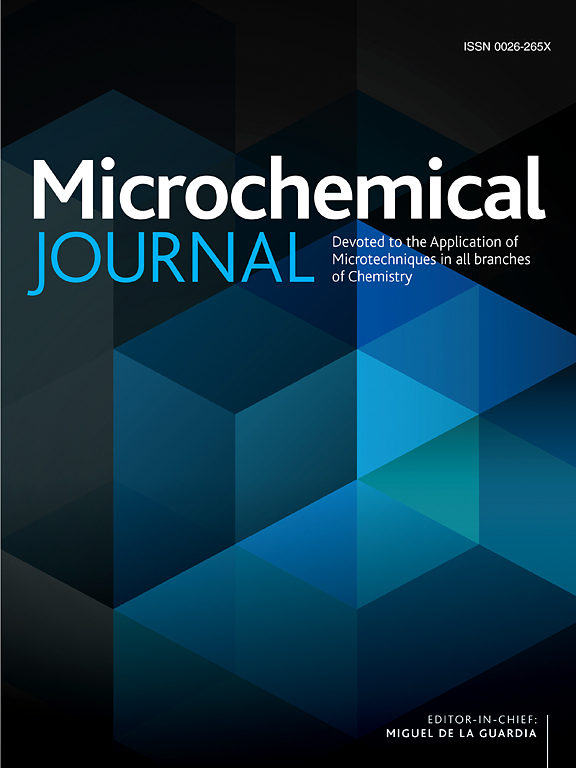使用基于智能手机的便携式设备,基于荧光测定妥布霉素
IF 4.9
2区 化学
Q1 CHEMISTRY, ANALYTICAL
引用次数: 0
摘要
本研究介绍了一种基于智能手机的强大便携式设备的开发情况,该设备采用基于荧光的方法测定药物和尿液中的妥布霉素。现有的妥布霉素分析方法通常需要复杂的设备和耗时的程序,而本研究提出的方法则具有简便、便携和实时监测的特点。光谱荧光法是基于妥布霉素和荧光胺在碱性介质中的反应。分析信号的测量由一个专门设计的装置实现,该装置集成了 3D 打印适配器、LED、微距镜头、基于 Arduino 的微控制器和智能手机。传统的光谱荧光测定法被用作参考方法。进行了初步和优化研究,以选择最合适的实验条件(如试剂浓度和反应时间)以及仪器参数(如选择合适的 RGB 模型组件、ISO 和白平衡)。对该方法的性能进行了验证,然后与传统的光谱荧光测定法进行了比较,结果表明其准确度和精确度相当。该方法在智能手机设备中的线性范围为 0.10-1.00 mg L-1,检测限为 0.03 mg L-1。对合成样品进行了测试,以验证分析的可用性,随后对药物和尿液样品进行了分析。该方法显示出良好的精密度(CV<3.4 %)和回收率(92.3-114.1 %),与光谱荧光法的结果(CV<5.9 %,回收率 92.3-119.8%)一致。与其他方法的比较凸显了所开发方法的简便性和高效性。研究表明,该方法与现有的成熟方法相比具有竞争力。所提议的装置试剂和样品消耗量低,结果可靠,适合在非实验室条件下进行随用随测的分析。本文章由计算机程序翻译,如有差异,请以英文原文为准。

Fluorescence-based determination of tobramycin using a portable smartphone-based device
The study presents the development of a robust portable smartphone-based device for determining tobramycin in drugs and urine by a fluorescence-based method. As existing analytical methods for the determination of tobramycin often require complex equipment and time-consuming procedures, the proposed approach offers simplicity, portability and real-time monitoring capabilities. The spectrofluorimetric method is based on the reaction of tobramycin and fluorescamine in an alkaline medium. The measurement of analytical signals was enabled with a specially designed device integrating a 3D printed adapter, LEDs, a macro lens, an Arduino-based microcontroller, and a smartphone. The traditional spectrofluorimetry was used as a reference method. Preliminary and optimisation studies were conducted to select the most suitable experimental conditions (e.g. reagent concentration and reaction time) as well as instrumental parameters (e.g. selection of the appropriate RGB model component, ISO, and white balance). The performance of the method was validated, and then verified against conventional spectrofluorimetry, showing comparable accuracy and precision. The method implemented in a smartphone-based device showed a linear range of 0.10–1.00 mg L-1 with a detection limit of 0.03 mg L-1. Synthetic samples were tested to verify analytical usability, followed by analysis of pharmaceutical and urine samples. The method showed good precision (CV<3.4 %) and recovery values (92.3–114.1 %), consistent with spectrofluorimetric results (CV<5.9 %, recovery 92.3–119.8 %). Comparison with other methods highlighted the simplicity and efficiency of the developed approach. The research reveals that it is competitive with existing well-established methods. The proposed device offers reliable results with low reagent and sample consumption, making it suitable for on-the-go analysis in non-laboratory conditions.
求助全文
通过发布文献求助,成功后即可免费获取论文全文。
去求助
来源期刊

Microchemical Journal
化学-分析化学
CiteScore
8.70
自引率
8.30%
发文量
1131
审稿时长
1.9 months
期刊介绍:
The Microchemical Journal is a peer reviewed journal devoted to all aspects and phases of analytical chemistry and chemical analysis. The Microchemical Journal publishes articles which are at the forefront of modern analytical chemistry and cover innovations in the techniques to the finest possible limits. This includes fundamental aspects, instrumentation, new developments, innovative and novel methods and applications including environmental and clinical field.
Traditional classical analytical methods such as spectrophotometry and titrimetry as well as established instrumentation methods such as flame and graphite furnace atomic absorption spectrometry, gas chromatography, and modified glassy or carbon electrode electrochemical methods will be considered, provided they show significant improvements and novelty compared to the established methods.
 求助内容:
求助内容: 应助结果提醒方式:
应助结果提醒方式:


